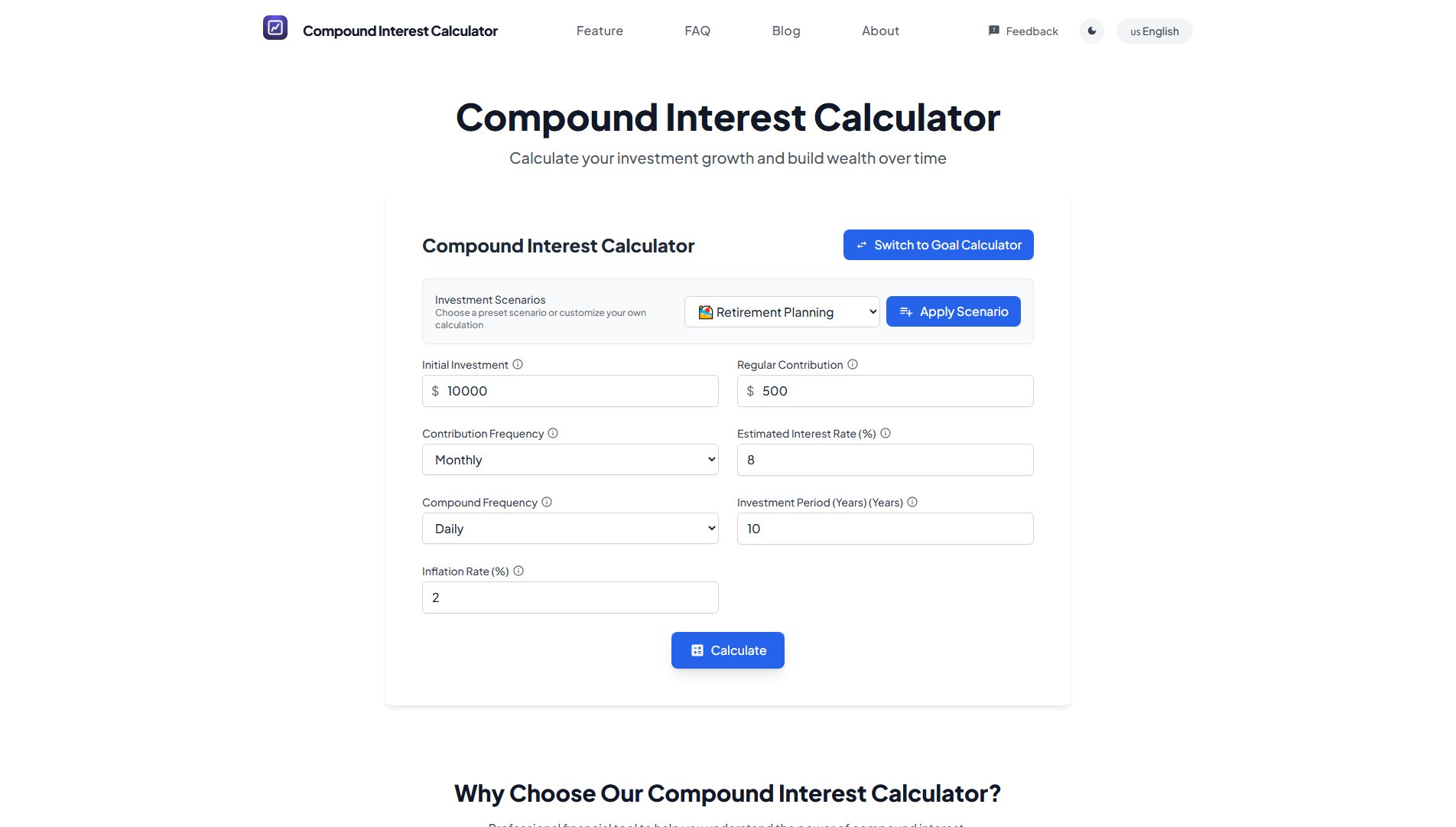Compound Interest Calculator
Free Investment Growth Tool for Wealth Building
What is Compound Interest Calculator? Complete Overview
The Compound Interest Calculator is a professional financial tool designed to help users understand and leverage the power of compound interest for long-term wealth growth. It solves the pain points of unclear investment projections by providing precise calculations and visual representations of how investments grow over time. This tool is ideal for general users, investors, financial planners, and anyone looking to plan for retirement, education funds, home down payments, emergency funds, or general wealth building. With features like multi-language support, inflation-adjusted calculations, and goal-oriented planning, it empowers users to make informed financial decisions.
Compound Interest Calculator Interface & Screenshots

Compound Interest Calculator Official screenshot of the tool interface
What Can Compound Interest Calculator Do? Key Features
Smart Compound Calculation
Accurate compound interest calculations with multiple compounding frequencies (daily, weekly, monthly, quarterly, semi-annual, and annual). This feature helps users understand how different compounding intervals affect their investment growth, enabling better financial planning.
Goal-Oriented Planning
Reverse calculate required investments based on financial goals. Users can determine the target amount, required years, monthly contributions, or return rate needed to achieve specific dreams like home down payments or retirement funds.
Visual Data Analysis
Intuitive charts and graphs (line charts, area charts, bar charts, and pie charts) to visualize investment growth. This makes complex financial data easy to understand and helps users track their progress over time.
Inflation-Adjusted Calculation
Consider inflation factors to calculate real purchasing power. Users can compare nominal returns vs. real returns to make more realistic long-term investment plans and protect their wealth from inflation erosion.
Multi-language Global Support
Supports multiple languages including Chinese, English, Japanese, French, and Spanish. This eliminates language barriers and provides a localized experience for users worldwide.
Easy Share & Export
Conveniently save and share calculation results. Supports image export, printing, and social sharing to help users record investment plans and share financial insights with others.
Best Compound Interest Calculator Use Cases & Applications
Retirement Planning
Plan for retirement by calculating how much you need to invest now or contribute regularly to reach your desired retirement fund. Adjust parameters like investment period and interest rate to see different outcomes.
Education Fund
Save for your child's education by determining the required monthly contributions to reach a target amount by the time they start college. Use the inflation-adjusted feature to ensure the fund retains its value.
Home Down Payment
Calculate how much you need to save monthly to accumulate a down payment for a home within a specific timeframe. The visual charts help track progress toward your goal.
Emergency Fund
Build an emergency fund by setting a target amount and determining how long it will take to reach it with regular contributions. The calculator helps you stay disciplined with your savings plan.
Wealth Building
Explore different investment scenarios to maximize wealth growth. Compare the effects of varying interest rates, compounding frequencies, and contribution amounts to find the optimal strategy.
How to Use Compound Interest Calculator: Step-by-Step Guide
Input Parameters: Enter the initial investment amount, regular contributions, contribution frequency, estimated interest rate, compound frequency, investment period, and inflation rate.
View Results: The calculator will display the investment return calculation results and detailed growth charts in real-time, showing how your investment grows over the specified period.
Adjust Strategy: Based on the results, adjust your investment strategy by tweaking parameters like contribution amount, frequency, or investment period to optimize your financial planning.
Save or Share: Export the results as an image, print them, or share them with others to discuss your financial plans or keep records for future reference.
Compound Interest Calculator Pros and Cons: Honest Review
Pros
Considerations
Is Compound Interest Calculator Worth It? FAQ & Reviews
Compound interest is the interest on a loan or deposit calculated based on both the initial principal and the accumulated interest from previous periods. It's like a snowball effect for your money, where you earn interest on your interest over time.
Compound interest is calculated using the formula A = P (1 + r/n)^(nt), where P is the principal amount, r is the annual interest rate, n is the number of times interest is compounded per year, and t is the time the money is invested for in years.
Compound interest is important because it allows your money to grow exponentially over time. The longer you invest, the more you benefit from the compounding effect, making it a powerful tool for wealth building.
Yes, compound interest can work against you if you're borrowing money. The interest on loans compounds over time, increasing the total amount you owe and making it harder to pay off the debt.
Simple interest is calculated only on the principal amount, while compound interest is calculated on the principal plus any accumulated interest. Compound interest grows faster because you earn interest on your interest.
Interest can be compounded at different intervals: daily, monthly, quarterly, semi-annually, or annually. The more frequently interest is compounded, the faster your investment grows.
Not all investments use compound interest, but many do, including savings accounts, certificates of deposit, and certain bonds. It's a common feature in long-term investment vehicles.
A good rate of return depends on the type of investment and market conditions. Generally, higher rates mean faster growth, but they also come with higher risks. It's important to find a balance that aligns with your financial goals and risk tolerance.